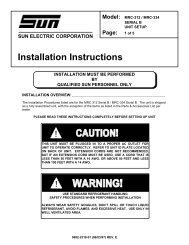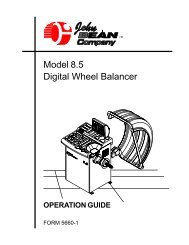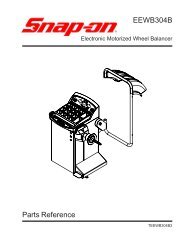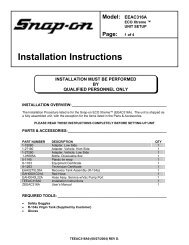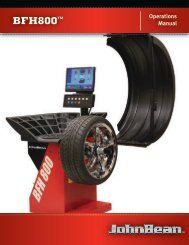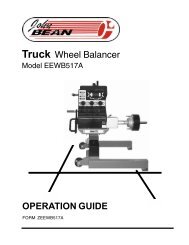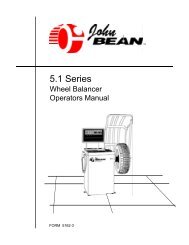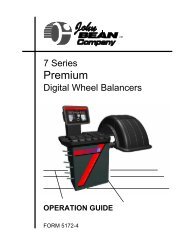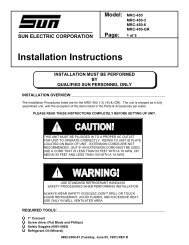CHAPTER 2 THEORY OF OPERATION - Snap-on Equipment
CHAPTER 2 THEORY OF OPERATION - Snap-on Equipment
CHAPTER 2 THEORY OF OPERATION - Snap-on Equipment
You also want an ePaper? Increase the reach of your titles
YUMPU automatically turns print PDFs into web optimized ePapers that Google loves.
<str<strong>on</strong>g>CHAPTER</str<strong>on</strong>g> 2 <str<strong>on</strong>g>THEORY</str<strong>on</strong>g> <str<strong>on</strong>g>OF</str<strong>on</strong>g> <str<strong>on</strong>g>OPERATION</str<strong>on</strong>g><br />
RECOVERY TANK<br />
The Recovery Tank stores up to 80% of recycled, filtered, and dried refrigerant. It has two manual hand valves,<br />
and a purge fitting located <strong>on</strong> top of the tank. During the Recycle mode the refrigerant enters the tank through<br />
the valve marked "VAPOR" (RED). In the charge (Dispense Refrigerant) mode, the refrigerant exits through the<br />
valve marked "LIQUID" (BLUE). This port has a tube, which reaches the bottom of the recovery tank. When<br />
using the recycle unit, open both valves <strong>on</strong> the recovery tank for proper operati<strong>on</strong>. During the auto purge mode,<br />
the n<strong>on</strong>-c<strong>on</strong>densable gas (AIR) exits through the yellow hose via the purge fitting. This process will release the<br />
n<strong>on</strong>-c<strong>on</strong>densable gas out of the purge valve <strong>on</strong> the fr<strong>on</strong>t panel of the unit. For more informati<strong>on</strong>, refer to<br />
PURGE MODE <strong>on</strong> page 2-3.<br />
LOAD CELL<br />
The Load Cell is the device that weighs the amount of the refrigerant in the tank. The load cell is made of four<br />
strain gauge resistors c<strong>on</strong>nected in a whetst<strong>on</strong>e bridge c<strong>on</strong>figurati<strong>on</strong>. The design of the C<strong>on</strong>troller Board <strong>on</strong>ly<br />
uses the Signal+ to read the amount <strong>on</strong> the scale. This voltage can be read <strong>on</strong> the A/D (U6 pin 3) to determine<br />
the amount <strong>on</strong> the scale. Example: Every 1 oz. divided by (/) 229.807.<br />
To determine the voltage reading with a certain amount <strong>on</strong> the scale, the math would follow:<br />
(40 lbs. x 16) + (0 oz.) / 229.807 = 2.78VDC.<br />
To determine the amount reading with voltage, then the math would follow:<br />
(2.09VDC x 229.807) / 16 = 30lbs. 0 oz.<br />
CUT<str<strong>on</strong>g>OF</str<strong>on</strong>g>F SWITCHES<br />
There is <strong>on</strong>e Cutoff Switch used in this unit, which is the High Pressure cutoff switch. This switch works the<br />
same way as a snap switch. When the pressure reaches 450 psi, the switch snaps open. When the pressure<br />
decreases to 375 psi, the switch then snaps closed.<br />
SUCTION SEPARATOR<br />
SWITCH DEACTUATION ACTUATION<br />
HIGH 375 psi 450 psi<br />
The Sucti<strong>on</strong> Separator assembly is located in the fr<strong>on</strong>t of the unit. Oil removed from the vehicle's A/C system is<br />
separated from the refrigerant and is accumulated in the separator bowl. The purpose of the Sucti<strong>on</strong> Separator<br />
is to remove c<strong>on</strong>taminants from the refrigerant being recovered. Refrigerant can enter the Sucti<strong>on</strong> Separator as<br />
a vapor or liquid. Any liquid entering must vaporize in order to exit through the outlet port at the top of the<br />
assembly. Once the refrigerant has changed from a liquid to a vapor state, the compressor will draw out the<br />
vapor.<br />
The remaining oil (if any) will need to be purged out via the oil drain valve. The amount of oil removed will be<br />
the amount of oil that should be added back to the vehicle. Refer to Appendix C Users Manual for more<br />
informati<strong>on</strong>.<br />
PRESSURE TRANSDUCER<br />
(Refer to Drawing 1-1 in Chapter 1)<br />
There is <strong>on</strong>ly <strong>on</strong>e transducer used in this unit, to m<strong>on</strong>itor the pressure in the recovery tank. The Purge<br />
Transducer is rated at 0 to 500 psia. The transducer outputs a voltage proporti<strong>on</strong>al to amount of the pressure<br />
sensed. Output voltage is 0.0 to 4.0 volts full scale, and with a 0.5 ± 0.1 volt zero offset.<br />
Example: Every 1 psi equals 8mv plus the 0.5 volt zero offset. At 250 psia, the output voltage is 2.5 ± 0.1 volt.<br />
Note, this transducer measures absolute pressure (PSIA) instead of gauge pressure (PSIG) and is not<br />
interchangeable with older <strong>on</strong>es.<br />
MASTER FILTER/DRIER<br />
When vapor refrigerant passes through the Master Filter/Dryer, it is dried/cleaned of all moisture. The master<br />
filter/drier is the <strong>on</strong>ly comp<strong>on</strong>ent that removes moisture from refrigerant. The master filter/drier should be<br />
changed when the filter counter (Timer) has reached (or counts down to) 0 pounds 0 ounces since the last<br />
master filter/drier change. The maximum amount of time for a new filter dryer is 95 pounds. For more<br />
informati<strong>on</strong> <strong>on</strong> tracking, refer to Appendix C Users Manual. This filter is designed to remove moisture from R-<br />
134a refrigerants.<br />
NOTE The unit is <strong>on</strong>ly designed to recover R134a refrigerant.<br />
Effective<br />
Page 2-8 01/2002



